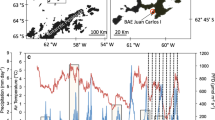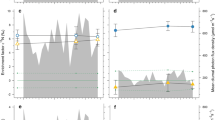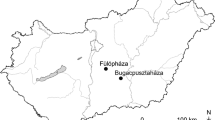Abstract
The activation of metabolism after the winter period was investigated in several mosses and lichens in continental Antarctica. Thalli that were still in their over-wintering inactive state in early spring were sprayed artificially and the time-dependent activation of photosystem II (PSII), carbon fixation and respiration was determined using gas exchange and chlorophyll a fluorescence techniques. The investigated lichens recovered PSII activity almost completely within the first few minutes and gross photosynthesis was fully reactivated within a few hours. In contrast, photosynthesis took much longer to recover in mosses, which could indicate a general difference between the green-algal symbionts in lichens and moss chloroplasts. Only small and quickly reversible increased rates of respiration were observed for the foliose lichen Umbilicaria aprina from a more xeric habitat. In contrast, species occurring near persistent meltwater, such as the moss Bryum subrotundifolium and the lichen Physcia caesia, had highly increased respiration rates that were maintained for several days after activation. Calculation of the carbon balances indicated that the activation pattern strongly dictated the length of time before a carbon gain was achieved. It appears that the differences in recovery reflect the water relations of the main growth period in summer.







Similar content being viewed by others
References
Bewley JD (1979) Physiological aspects of desiccation tolerance. Annu Rev Plant Physiol 30:195–238
Bewley JD (1995) Physiological aspects of desiccation tolerance: a retrospect. Int J Plant Sci 156:393–403
Brown D, MacFarlane JD, Kershaw KA (1983) Physiological–environmental interactions in lichens XVI: a re-examination of resaturation respiration phenomena. New Phytol 93:237–246
Csintalan Z, Takacs Z, Proctor MCF, Lichtenthaler HK, Tuba Z (1998) Desiccation and rehydration responses of desiccation tolerant moss and lichen species from a temperate semidesert grassland. J Hattori Bot Lab 84:71–80
Csintalan Z, Proctor MCF, Tuba Z (1999) Chlorophyll fluorescence during drying and rehydration in the mosses Rhytidiadelphus loreus (Hedw.) Warnst., Anomodon viticulosus (Hedw.) Hook. & Tayl. and Grimmia pulvinata (Hedw.) Sm. Ann Bot 84:235–244
Davey MC (1997a) Effects of continuous and repeated dehydration on carbon fixation by bryophytes from the maritime Antarctic. Oecologia 110:25–31
Davey MC (1997b) Effects of short-term dehydration and rehydration on photosynthesis and respiration by antarctic bryophytes. Environ Exp Bot 37:187–198
Davey MC, Rothery P (1996) Seasonal variation in respiratory and photosynthetic parameters in three mosses from the maritime Antarctic. Ann Bot 78:719–728
Dilks TJK, Proctor MCF (1974) The pattern of recovery of bryophytes after desiccation. J Bryol 8:97–115
Dilks TJK, Proctor MCF (1976a) Effects of intermittent desiccation on bryophytes. J Bryol 9:249–264
Dilks TJK, Proctor MCF (1976b) Seasonal variation in desiccation tolerance in some British bryophytes. J Bryol 9:239–247
Ensgraber A (1954) Über den Einfluß der Antrocknung auf die Assimilation und Atmung von Moosen und Flechten. Flora 141:432–475
Farrar JF, Smith DC (1976) Ecological physiology of the lichen Hypogymnia physodes. III. The importance of the rewetting phase. New Phytol 77:115–125
Gannutz TP (1969) Effects of environmental extremes on lichens. In: Werner RG (ed) Colloque sur les lichéns et la symbiose lichenique. Societé Botanique de France, Paris, pp 169–179
Green TGA, Lange OL (1994) Photosynthesis in poikilohydric plants: a comparison of lichens and bryophytes. In: Schulze E-D, Caldwell MC (eds) Ecophysiology of photosynthesis. Springer, Berlin Heidelberg New York, pp 319–341
Green TGA, Kilian E, Lange OL (1991) Pseudocyphellaria dissimilis: a desiccation-sensitive, highly shade-adapted lichen from New Zealand. Oecologia 85:498–503
Green TGA, Schroeter B, Sancho LG (1999) Plant life in Antarctica. In: Pugnaire FI, Valladares F (eds) Handbook of functional plant ecology. Dekker, Basel, pp 495–543
Hartung W, Schiller P, Dietz K-J (1998) Physiology of poikilohydric plants. Prog Bot 59:299–327
Heber U, Bilger W, Bligny R, Lange OL (2000) Phototolerance of lichens, mosses and higher plants in an alpine environment: analysis of photoreactions. Planta 211:770–780
Hicklenton PR, Oechel WC (1976) Physiological aspects of the ecology of Dicranum fuscescens in the subarctic. I. Acclimation and acclimation potential of CO2 exchange in relation to habitat, light, and temperature. Can J Bot 54:1104–1119
Hinshiri HM, Proctor MCF (1971) The effect of desiccation on subsequent assimilation and respiration of the bryophytes Anomodon viticulosus and Porella platyphylla. New Phytol 70:527–538
Ingram J, Bartels D (1996) The molecular basis of dehydration tolerance in plants. Annu Rev Plant Physiol Plant Mol Biol 47:377–403
Kappen L (1988) Ecophysiological relationships in different climatic regions. In: Galun M (ed) CRC handbook of lichenology. CRC Press, Boca Raton, pp 37–100
Kappen L (1993) Lichens in the Antarctic region. In: Friedmann EI (ed) Antarctic microbiology. Wiley, Mannheim, pp 433–490
Kappen L (2000) Some aspects of the great success of lichens in Antarctica. Antarct Sci 12:314–324
Kappen L, Valladares F (1999) Opportunistic growth and desiccation tolerance: the ecological success of poikilohydrous autotrophs. In: Pugnaire FI, Valladares F (eds) Handbook of functional plant ecology. Dekker, Basel, pp 9–80
Kappen L, Smith RIL, Meyer M (1989) Carbon dioxide exchange of two ecodemes of Schistidium antarctici in continental Antarctica. Polar Biol 9:415–422
Lange OL (1965) Der CO2-Gaswechsel von Flechten bei tiefen Temperaturen. Planta 64:1–19
Lange OL (1969) CO2-Gaswechsel von Moosen nach Wasserdampfaufnahme aus dem Luftraum. Planta 89:90–94
Lange OL, Bilger W, Rimke S, Schreiber U (1989) Chlorophyll fluorescence of lichens containing green and blue-green algae during hydration by water vapour uptake and by addition of liquid water. Bot Acta 102:306–313
Lange OL, Green TGA, Heber U (2001) Hydration-dependent photosynthetic production of lichens: what do laboratory studies tell us about field performance. J Exp Bot 52:2033–2042
Larson DW (1978) Patterns of lichen photosynthesis and respiration following prolonged frozen storage. Can J Bot 56:2119–2123
Larson DW (1989) The impact of ten years at −20°C on gas exchange in five lichen species. Oecologia 78:87–92
Larson DW, Kershaw KA (1975a) Acclimation of arctic lichens. Nature 254:421–423
Larson DW, Kershaw KA (1975b) Studies on lichen-dominated systems. XIII. Seasonal and geographical variation of net CO2 exchange of Alectoria ochroleuca. Can J Bot 53:2598–2607
Larson DW, Kershaw KA (1975c) Studies on lichen-dominated systems. XVI. Comparative patterns of net CO2 exchange in Cetraria nivalis and Alectoria sarmentosa collected from a raised-beach ridge. Can J Bot 53:2884–2892
Oechel WC (1976) Seasonal patterns of temperature response of CO2 flux and acclimation in arctic mosses growing in situ. Photosynthetica 10:447–456
Oechel WC, Sveinbjörnsson B (1978) Primary production progresses in the arctic bryophytes at Barrow, Alaska. In: Tieszen LL (ed) Vegetation and production ecology of an alaskan arctic tundra. (Ecological studies 29) Springer, Berlin Heidelberg New York, pp 269-298
Oliver MJ, Bewley JD (1997) Desiccation-tolerance of plant tissues: a mechanistic overview. Hortic Rev 18:171–213
Palmqvist K (2000) Tansley review no. 117: carbon economy in lichens. New Phytol 148:11–36
Pannewitz S, Schlensog M, Green TGA, Sancho LG, Schroeter B (2003) Are lichens active under snow in continental Antarctica? Oecologia 135:30–38
Proctor MCF (2000) Physiological ecology. In: Shaw AJ, Goffinet B (eds) Bryophyte biology. Cambridge University Press, Cambridge, pp 225–247
Proctor MCF, Smirnoff N (2000) Rapid recovery of photosystems on rewetting desiccation-tolerant mosses: chlorophyll fluorescence and inhibitor experiments. J Exp Bot 51:1695–1704
Ried A (1960) Thallusbau und Assimilationshaushalt von Laub- und Krustenflechten. Biol Zentralbl 79:129–151
Scheidegger C, Frey B, Schroeter B (1997) Cellular water uptake, translocation and PSII activation during rehydration of desiccated Lobaria pulmonaria and Nephroma bellum. In: Kappen L (ed) New species and novel aspects in ecology and physiology of lichens. (In honour of O.L. Lange) Bornträger Verlagsbuchhandlung, Berlin, pp 105–117
Schroeter B, Scheidegger C (1995) Water relations in lichens at subzero temperatures: structural changes and carbon dioxide exchange in the lichen Umbilicaria aprina from continental Antarctica. New Phytol 131:273–285
Schroeter B, Kappen L, Moldaenke C (1991) Continuous in situ recording of the photosynthetic activity of Antarctic lichens—established methods and a new approach. Lichenologist 23:253–265
Schroeter B, Green TGA, Kappen L, Seppelt RD (1994) Carbon dioxide exchange at subzero temperatures. Field measurements on Umbilicaria aprina in Antarctica. Cryptogam Bot 4:233–241
Schroeter B, Kappen L, Green TGA, Seppelt RD (1997a) Lichens and the Antarctic environment: effects of temperature and water availability on photosynthesis. In: Lyons WB, Howard-Williams C, Hawes I (eds) Ecosystem processes in Antarctic ice-free landscapes. Balkema, Rotterdam, pp 103–117
Schroeter B, Schulz F, Kappen L (1997b) Hydration related spatial and temporal variation of photosynthetic activity in Antarctic lichens. In: Battaglia B, Valencia J, Walton DWH (eds) Antarctic communities. Species, structure and survival. Cambridge University Press, Cambridge, pp 221–225
Schroeter B, Sancho LG, Valladares F (1999) In situ comparison of daily photosynthetic activity patterns of saxicolous lichens and mosses in Sierra de Guadarrama, Central Spain. Bryologist 102:623–633
Smith DC, Molesworth S (1973) Lichen physiology. XIII. Effects of rewetting dry lichens. New Phytol 72:525–533
Tuba Z, Csintalan Z, Proctor CF (1996) Photosynthetic responses of a moss, Tortula ruralis ssp. ruralis, and the lichens Cladonia convoluta and C. furcata to water deficit and short periods of desiccation, and their ecophysiological significance: a baseline study at present-day CO2 concentration. New Phytol 133:353–361
Wharton DA (1997) Survival of low temperatures by the Antarctic nematode Panagrolaimus davidi. In: Lyons WB, Howard-Williams C, Hawes I (eds) Ecosystem processes in Antarctic ice-free landscapes. Balkema, Rotterdam, pp 57–60
Wharton DA, Block W (1997) Differential scanning calorimetry studies on an Antarctic nematode (Panagrolaimus davidi) which survives intracellular freezing. Cryobiology 34:114–121
Acknowledgements
Antarctica New Zealand, who provided all the transport and logistics, is gratefully thanked for the excellent organisation and support in Christchurch, Scott Base and in the field. In particular, Jim Cowie and the team from the Cape Roberts Drilling Programme are thanked for establishing our camp and ensuring an easy and rapid start to the season and Pete Cleary is thanked for co-ordinating our support and logistics. The study was financed by a special grant from Professor Bryan Gould, Vice-Chancellor, Waikato University, and by a grant of the “Deutsche Forschungsgemeinschaft” to B.S. (DFG 473/4-3).
Author information
Authors and Affiliations
Corresponding author
Rights and permissions
About this article
Cite this article
Schlensog, M., Pannewitz, S., Green, T.G.A. et al. Metabolic recovery of continental antarctic cryptogams after winter. Polar Biol 27, 399–408 (2004). https://doi.org/10.1007/s00300-004-0606-4
Received:
Accepted:
Published:
Issue Date:
DOI: https://doi.org/10.1007/s00300-004-0606-4




